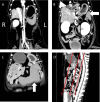Agenesis of hepatic lobes in a dog
- PMID: 30775289
- PMCID: PMC6356100
- DOI: 10.4314/ovj.v8i4.21
Agenesis of hepatic lobes in a dog
Abstract
Agenesis of a hepatic lobe is an extremely rare congenital anomaly and only one dog have been reported in veterinary literature. We encountered a dog with this anomaly diagnosed by Computed tomography (CT) and portography. A two-year-old, 6.9-kg female Shih tzu dog was presented with vomiting and anorexia. The dog had no history of abdominal surgery or trauma. Biochemical analysis showed elevated plasmatic liver enzymes. CT revealed the absence of the liver parenchyma and vascular system of the left lobe, quadrate lobe and papillary process of the caudate lobe. A portosystemic shunt was also observed. The liver parenchyma and vascular system of these lobes were not detected under digital subtraction angiography during laparotomy. Furthermore, the liver parenchyma and vascular system of these lobes were not detected even when the remaining liver volume increased two months after treating the shunt vessel. CT proved itself a good option for antemortally diagnosis of hepatic agenesis in a dog.
Keywords: Computed tomography; Dog; Hepatic lobe agenesis; Liver; Portosystemic shunts.
Figures




References
-
- Buob S, Johnston A.N, Webster C.R. Portal hypertension: pathophysiology, diagnosis, and treatment. J. Vet. Intern. Med. 2011;25:169–186. - PubMed
-
- Doran I.P, Barr F.J, Hotston Moore A, Knowles T.G, Holt P.E. Liver size, bodyweight, and tolerance to acute complete occlusion of congenital extrahepatic portosystemic shunts in dogs. Vet. Surg. 2008;37:656–662. - PubMed
-
- Iannelli A, Facchiano E, Fabiani P, Sejor E, Bernard J.L, Niezar E, Gugenheim J. Agenesis of the right liver: a difficult laparoscopic cholecystectomy. J. Laparoendosc. Adv. Surg. Tech. A. 2005;15:166–169. - PubMed
-
- Inoue T, Ito Y, Matsuzaki Y, Okauchi Y, Kondo H, Horiuchi N, Nakao K, Iwata M. Hypogenesis of right hepatic lobe accompanied by portal hypertension: case report and review of 31 Japanese cases. J. Gastroenterol. 1997;32:836–842. - PubMed
-
- Kakitsubata Y, Nakamura R, Mitsuo H, Suzuki Y, Kakitsubata S, Watanabe K. Absence of the left lobe of the liver: US and CT appearance. Gastrointest. Radiol. 1991;16:323–325. - PubMed
Publication types
LinkOut - more resources
Full Text Sources
